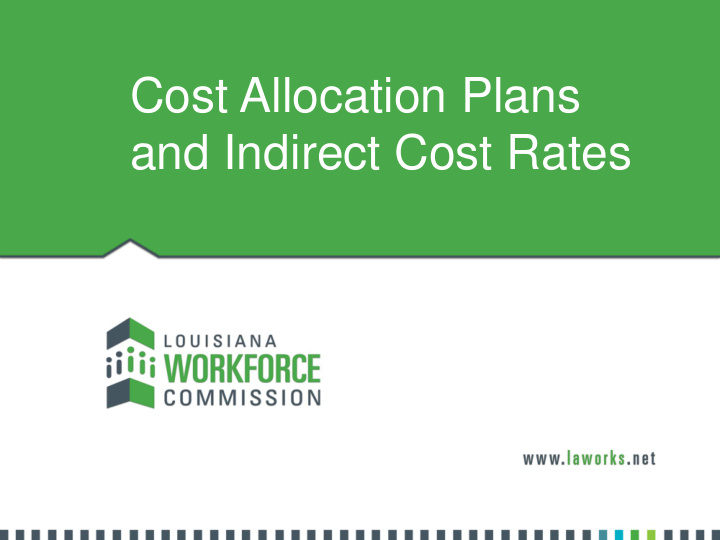



Cost Allocation Plans and Indirect Cost Rates
Cost Allocation Plans and Indirect Cost Rates Method of charging shared or common cost among different funding sources
Cost Allocation Plan (CAP) Charges current shared cost to funding sources currently. Pros: – The cost incurred this year is charged to funding sources this year. – No adjustments needed after year is over. Cons: – If have many funding sources with different year ends, can be difficult to apply. – Difficult to budget.
Negotiated Indirect Cost Rate (NICR) Pros: – Easier to budget. – If you can project the base cost, you can budget Indirect Costs. Cons: – Depending on type of rate, may require post year adjustments. – May incur more indirect cost than can charge to funding sources and therefore need a cash source to cover.
What is included as Indirect Cost Costs incurred for common or joint objectives and that cannot be readily identified with a particular final cost objective. Exclude capital expenditures and unallowable costs. A cost may not be allocated to a Federal award as indirect cost if any other costs incurred for same purpose, in like circumstances, has been assigned as a direct cost.
Distribution Base Typical Distribution Bases: Direct Salaries and Benefits Direct Salaries excluding Benefits Modified Total Direct Cost (MTDC) – Excludes capital costs, subawards >$25,000, participant support costs, etc.
Distribution Base (cont’d) The selection of the base is determined by considering the one best suited for assigning the pool of costs to cost objectives in accordance with benefits received. You must select the base which produces results that are equitable to both the Federal Government and the organization.
Indirect Cost Rate Calculated Total Indirect Cost . Indirect Cost Rate = Total Distribution Base
Types of Rates Predetermined: Rate based on an estimate of the costs to be incurred during the period. Rate is not subject to adjustment. Used where there is reasonable assurance, based on past experience and reliable projection of the organization’s cost, that the rate is not likely to exceed a rate based on the organization’s actual costs.
Types of Rates (cont’d) Fixed: Rate based on an estimate of the costs to be incurred during the period. Difference between estimated cost and actual cost is carried forward as an adjustment to the rate computation of a subsequent period. Not to be used if substantial portion of organization’s Federal awards are expected to expire before the carryforward adjustment can be made or if organization’s operations fluctuate significantly from year to year.
Types of Rates (cont’d) Provisional / Final: Temporary rate used during period for interim reimbursement and reporting. The final rate is determined after the period is over and is based on the actual cost of the period. The final rate is not subject to adjustment. Used when neither predetermined nor fixed rates are appropriate.
Types of Rates (cont’d) Deminimis: If never have negotiated an indirect cost rate, may use a rate of 10% of modified total direct cost.
Negotiation of Rates Cognizant agency for indirect costs is the Federal agency with the largest dollar value of direct Federal awards with the organization. Once determined, assignment will not change unless there is a shift in the dollar volume for at least three years. If an organization only receives funds as a subrecipient, then will enter negotiations with the pass through entity providing the federal funds or use the deminimis 10% rate
Contact List US Department of Labor: – Office of Assistant Secretary for Administration & Management, • Office of Cost Determination https://www.dol.gov/agencies/oasam/centers-offices/business-operations- center/business-operations-center/cost-determination/contact US Department of Health and Human Services: – Office of Assistant Secretary for Administration & Management, Program Support Center – Cost Allocation Services https://rates.psc.gov/
Recommend
More recommend